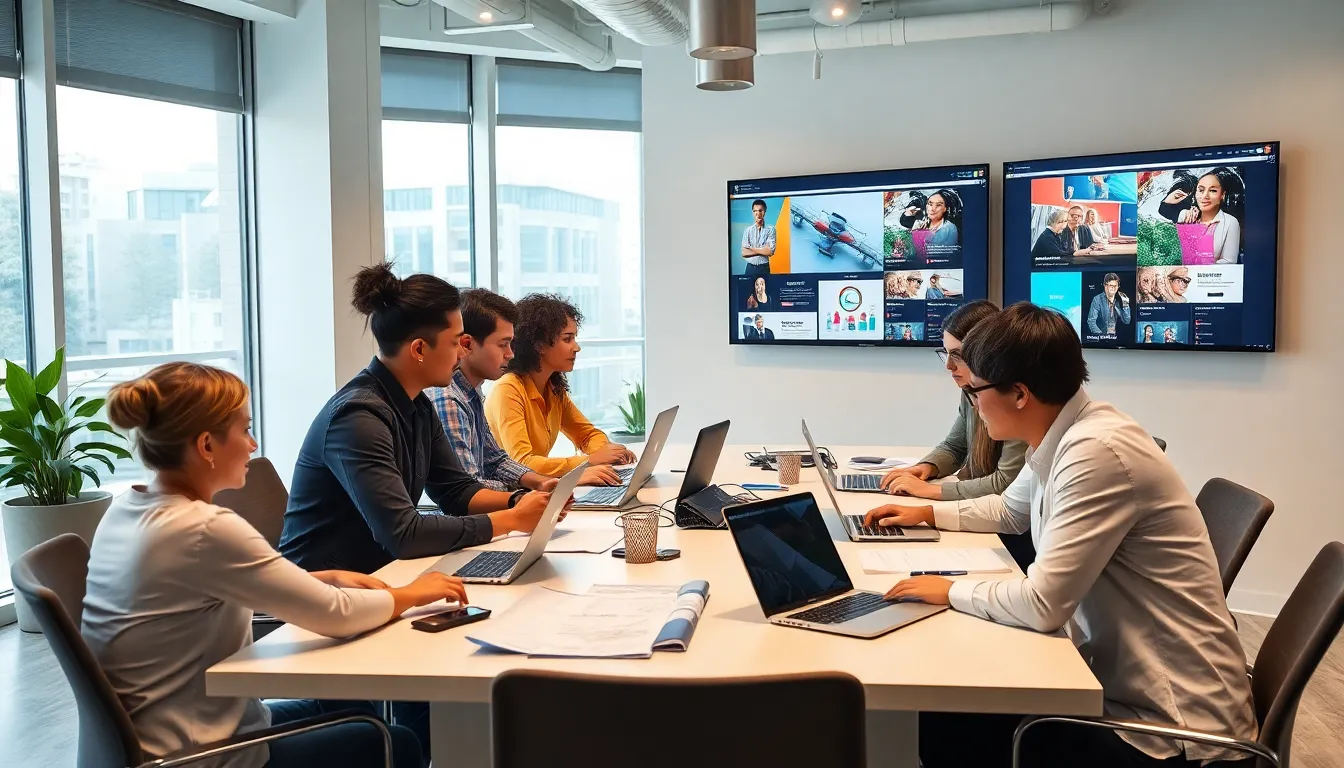In today’s digital age, a website isn’t just a pretty face; it’s the first impression that can make or break a business. With countless options at their fingertips, users won’t hesitate to bounce off a site that looks like it’s stuck in the early 2000s. So, what’s the secret sauce for captivating web design?
Table of Contents
ToggleUnderstanding Website Design Concepts
Website design encompasses various principles and techniques that enhance user experience and functionality. Design elements like layout, color schemes, typography and images shape how users perceive and interact with a website. Focusing on user-centric designs increases engagement by ensuring that visitors can navigate easily.
Effective layout design organizes content logically. Grid systems guide arrangement, creating balance and harmony. Typography plays a key role in establishing a website’s brand voice. It’s essential to select fonts that are legible and appropriate for the target audience.
Color schemes impact emotions and perceptions. Using a consistent color palette improves brand recognition, while contrasting colors direct attention to call-to-action buttons. Imagery also influences user experience; high-quality images attract attention and make content more relatable.
Mobile responsiveness is critical in today’s digital landscape. Many users access websites on smartphones or tablets, necessitating designs that adapt to different screen sizes. Implementing responsive design ensures usability across devices.
Loading speed affects user retention significantly. A delay of even a few seconds can lead to increased bounce rates. Optimizing images and leveraging caching techniques can enhance performance, keeping users engaged.
Finally, incorporating feedback through user testing helps refine design concepts. Gathering insights from actual users enables designers to identify challenges and make data-driven adjustments. This ongoing process ensures that a website evolves to meet user needs consistently.
These key concepts guide designers in creating engaging and functional websites that attract and retain users effectively.
Key Elements of Effective Web Design

Effective web design relies on various fundamental elements that enhance user experience and functionality. These components come together to form a cohesive and engaging digital presence.
Layout and Structure
A well-organized layout guides users through the website effortlessly. Clear navigation ensures visitors find information quickly without confusion. Consistent alignment and spacing enhance readability and visual appeal. Users notice that a grid system often creates balanced designs, enabling better flow and content organization. Fluid responsiveness accommodates different screen sizes, crucial as users browse on mobile devices. Logical grouping of related content helps users absorb information without feeling overwhelmed.
Color Theory and Typography
Color theory affects emotions and perceptions, influencing how users interact with a site. Choosing complementary colors creates visual harmony, while appropriate contrast enhances readability. Specific colors evoke different feelings, such as trust or excitement, impacting user engagement. Typography plays a significant role in conveying brand identity, ensuring text remains legible across devices. Consistent font choices reassure users and enhance familiarity. Hierarchical use of text sizes and styles helps convey the importance of information, guiding user focus effectively.
Best Practices for User Experience
User experience hinges on intuitive design that facilitates smooth interactions. Prioritizing user needs and preferences creates pathways for effective engagement.
Navigation and Accessibility
Effective navigation ensures users find information quickly. A clear menu structure guides users through the site without confusion. Different device users benefit from accessible navigation options, such as keyboard shortcuts and voice commands. Alt text for images improves accessibility for visually impaired users, making content more inclusive. Structuring links logically also aids in enhancing usability and accessibility. Using descriptive labels ensures clarity, while breadcrumbs help users understand their location within the site.
Mobile Responsiveness
Mobile responsiveness accommodates users accessing websites on various devices. Designing for smaller screens requires a fluid layout that adapts without sacrificing functionality. Content should resize appropriately, maintaining readability and visual appeal. Touch targets need to be large enough for easy interaction, minimizing frustration. Optimizing loading speed on mobile devices further retains user attention. Fluid grids allow elements to adjust gracefully, ensuring that images and text scale correctly. These practices enhance overall user experience, fostering retention and engagement.
Evolving Trends in Website Design
Website design continuously adapts to emerging technologies and user preferences. Staying current with trends ensures businesses maintain relevance in a competitive landscape.
Minimalism and Flat Design
Minimalism emphasizes simplicity by stripping away unnecessary elements. Designers opt for clean lines and ample white space to enhance focus on content. This approach reduces distractions, allowing users to engage with core messages effectively. Flat design complements minimalism through the use of two-dimensional visuals and bold colors. Using simple shapes and icons helps convey information without clutter. Websites employing these techniques often load faster, improving overall user experience.
Dynamic and Interactive Elements
Dynamic elements capture user attention by creating engaging experiences. Features like animated buttons and hover effects foster interaction, making websites feel alive. Interactivity encourages users to explore content further, increasing engagement time. Integrating multimedia components, such as videos and sliders, enhances storytelling capabilities. These dynamic features cater to diverse user preferences, appealing to various demographics. By utilizing these elements, designers create memorable experiences that encourage repeat visits.
Tools and Resources for Designers
Designers utilize various tools and resources to enhance their web design projects. Popular graphic design software includes Adobe Photoshop, Illustrator, and Figma, which allow for creating stunning visual elements. Collaboration tools like Slack and Trello enable teams to stay organized and communicate effectively throughout the design process.
Wireframing tools such as Sketch and Adobe XD help visualize the structure and flow of websites before development begins. These applications offer features that streamline design ideas into comprehensible blueprints. Prototyping tools like InVision and Marvel provide interactive models that showcase how users will interact with the final product.
Color picking tools like Coolors and Adobe Color assist designers in generating appealing color palettes. Typography resources such as Google Fonts and Adobe Fonts offer various typefaces that convey brand identity and enhance readability. Designers also benefit from stocks images and icons available on platforms like Unsplash and Font Awesome.
Accessibility testing tools, including WAVE and Axe, ensure websites meet necessary standards for users with disabilities. Performance evaluation tools like Google PageSpeed Insights provide insight into loading speed and optimization opportunities. These resources aid in fine-tuning designs for better user experience, so designers regularly incorporate them into their workflow.
Learning platforms such as Coursera and Udemy offer courses on the latest design trends and techniques. Workshops and design communities like Behance and Dribbble foster creative collaboration and inspiration. Utilizing these tools and resources streamlines the design process, fosters innovation, and supports the ongoing development of effective web design concepts.
Effective website design is more than just aesthetics; it’s about creating a seamless experience that resonates with users. By prioritizing elements like layout color schemes and typography businesses can significantly enhance user engagement. Staying updated with design trends and utilizing the right tools streamlines the design process while ensuring websites remain relevant and functional.
As the digital landscape evolves businesses must adapt their web design strategies to meet user expectations. Emphasizing mobile responsiveness and accessibility not only broadens audience reach but also fosters an inclusive online environment. Ultimately a well-designed website serves as a powerful tool for driving user interaction and achieving business goals.

